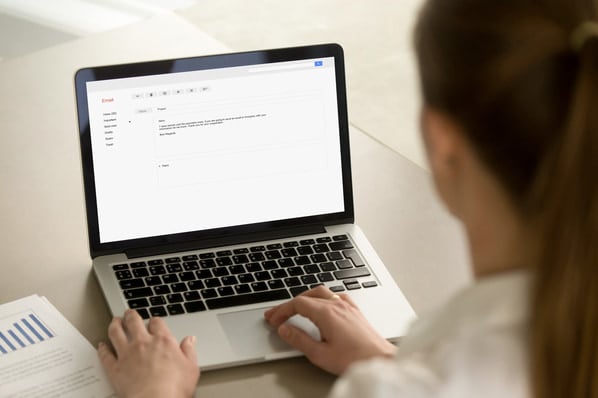Whether you're introducing yourself at a networking event, telling new colleagues about your business, or pitching to another professional — you want to capture attention and get it fast. In situations like these, you need a short and easy-to-grasp explanation of your company and its products, like an elevator pitch.

In this post, we'll discuss what an elevator pitch is, review some helpful examples, see some elevator pitch templates you can reference, go over some elevator pitch best practices, and cover some key mistakes you need to avoid when delivering one of these speeches.
Let's dive in.
Table of Contents
- What is an elevator pitch?
- Elevator Speech Example
- How to Write an Elevator Pitch
- Elevator Pitch Templates
- 30-Second Elevator Pitch Examples
- Elevator Pitches From Real Sales Leaders
- Elevator Speech Best Practices
- What Not to Do in an Elevator Pitch
What is an elevator pitch?
An elevator pitch — also known as an elevator speech — is a short, memorable description of what you do and/or what you sell. The goal is to earn a second conversation, not to convince the person you're talking to that they should hire you or buy your solution.
An elevator pitch is never an opportunity to close a deal. It‘s an opportunity to close more of your prospect’s attention and time. It's a quick introduction to you, your company, and how you can help your prospect.
Elevator Speech Example
Hi, I‘m an account manager with Vacation Locator. We help travelers across the world plan their perfect holiday based on their interests, budget, and location preferences. With travel experts assigned to each account, we find the best deals and most unique experiences for each client, so they can enjoy their vacation, instead of stressing out about planning it. On average, we’re able to save travelers up to 30% on expenses such as hotel and airfare.
When to use an elevator pitch?
You can pull your elevator pitch out at functions like networking events or conferences, over interactions like warm calls, and even in job interviews or at career fairs. Keep your elevator pitch goal-oriented — for instance, "I help companies like yours increase production by up to 30% without additional cost."— and always end with a business card or request to connect on LinkedIn.
If you‘re curious about what an elevator pitch should look like, or simply ready to jumpstart the pitch creation process, download the templates below. We’ve compiled several types of templates — from sales pitches to funding requests.
No matter which type of pitch you‘re delivering, keeping things concise is key. You don’t want to waste your prospect‘s, investor’s, or fellow professional‘s time. With that in mind, let’s take a look at how much time should you spend on an elevator pitch?
.png)
Download Now: Free Elevator Pitch Templates
E-pitch templates to better sell your product, fund your business, or network.
- 4 Fundraising Pitch Templates
- 2 Networking Pitch Templates
- 2 Sales Pitch Templates
How long should an elevator pitch be?
An effective elevator pitch is meant to be no more than 30 seconds, just like the length of time you ride in an elevator. You want to keep your words easily digestible, so avoid trying to get too deep into specifics as it can drag on the conversation — and lose your prospect's attention.
You should have an effective elevator pitch prepared before you need it since you have such a short window to deliver it. Your pitch needs purpose, flow, and a hook to reel in attention if you want to get the kind of mileage you need out of it in 30-ish seconds.
Let's take a closer look at how to put one of these pitches together.
How to Write an Elevator Pitch
1. Use elevator pitch templates.
Download Free E-Pitch Templates
Every elevator pitch has to start somewhere, and there‘s no better “somewhere to start” than HubSpot’s handy suite of easy-to-use elevator pitch templates. I‘m not exaggerating when I say they literally provide the best reference points for constructing thoughtfully tailored, effective elevator pitches you’ll find anywhere on the internet. Call my bluff.
HubSpot has templates to help you structure pitches for three key audiences: prospects, investors, and potential network connection — and while we trust that you, our valued readers, are capable of coming up with elevator pitches on your own, having these templates makes that process exponentially easier, freeing you up to focus on selling, crushing quota, and living your best life.
Okay, I‘m done with our plug — and now that I’ve essentially elevator pitched you on our suite of templates for elevator pitching, let's dive into the ins and outs of fleshing out an elevator pitch of your own.
2. Introduce yourself.
The value of a personal introduction in an elevator pitch is multifaceted. For one, it gives your prospect some pretty mission-critical context — you won‘t get too much mileage out of an elevator pitch if they have no idea who you are or who you’re with.
Second, it can make the whole experience a bit more approachable. You don't want things to be too rigid or imposing when you pitch — a friendly introduction helps set the stage for a more natural engagement.
Bear in mind — you need to know what your prospect needs to know. What I mean is that you have to be mindful of how much information you‘re sharing as part of your introduction. You don’t want to get lost, ramble, and share more information than your prospect needs to know. Get it?
Effective elevator pitches are delivered in a tight window — you don‘t want to waste time rattling off details like how long you’ve worked at your company, what job you had before, or how much you like working for your employer.
Stick to the essentials, be friendly, and get on with the pitch.
3. State your company's mission.
Want me to let you in on some next-level, mind-blowing insight? Ready? Here we go — you need to know what your business does if you're going to pitch it effectively. Revolutionary stuff, right?
Seriously though, you want to include some insight about your business — and a lot of the time, that means briefly speaking to its mission and goals. Including a section where you give a thoughtfully tailored reference to your company identity can give a prospect valuable context and develop a little trust on a dime.
You don‘t have to give a comprehensive rundown of every project you’re working on or fondly reminisce about the team retreat where you picked up trash on the local beach. It can be as simple as something like, “I'm a sales rep at Better Than the Rest Cable. We help hotels across the U.S. pair with the perfect cable provider and plan for their region and needs.”
That description is both succinct and sufficient. It covers the necessary bases without getting too deep into the weeds. If you were to be cut off after these two sentences, the prospect would still know exactly who you are and what your company does. You know — the stuff your prospect needs to know.
4. Explain the company value proposition.
This might be the most important base to cover. A prospect isn‘t going to be interested in a solution that they can’t see the value in, so naturally, you need to be able to articulate a compelling value proposition in your pitch.
Unless you're at the forefront of some sort of technological revolution, your product or service exists in a competitive landscape — so your prospect is bound to have some options. Why should they choose you?
You need to provide a sentence or two that covers why your product or service is worth it — why your current customers are so happy with you. Here's what that could look like:
“I'm a sales rep at Better Than the Rest Cable. We help hotels across the U.S. pair with the perfect cable provider and plan for their region and needs. With regional experts assigned to each account, we help hotels identify the most cost-effective and guest-delighting cable plan for them.”
In one sentence, you‘ve told the prospect what sets you apart and how you can bring them value. You’ve likely piqued their interest, but how can you really grab their attention? Keep reading.
5. Grab their attention with a hook.
You‘ve spent the pitch up to this point lining them up, now knock them down. Give them the bit that’s going to prompt that second conversation — hit them with the hook.
That can come in the form of an enthralling story about a customer, some exhilarating information about your company's founders, a fascinating statistic about your offering, or something else that's neat and engaging to round things out and keep them interested.
Let‘s finish up the pitch we’ve been running with with an attention-grabbing statistic.
“I‘m a sales rep at Better Than the Rest Cable. We help hotels across the U.S. pair with the perfect cable provider and plan for their region and needs. With regional experts assigned to each account, we help hotels identify the most cost-effective and guest-delighting cable plan for them. On average, we’re able to save hotels up to 25% on their annual cable bills.”
6. Make sure your pitch is more conversational and less “sales-y.”
According to Patrick Beltran, Marketing Director at Ardoz Digital, you want to "[a]void sounding too sales-y. In my experience, people often shy away from elevator pitches that feel like a typical sales pitch. Your elevator pitch should come across more like a casual chat than a sales pitch. The aim is to spark interest, making the listener curious to learn more, not to seal the deal immediately.
"To make your pitch sound conversational, use a relaxed tone and steer clear of jargon. For instance, rather than saying ‘We offer cutting-edge solutions,’ say ‘We provide innovative solutions.’
"And instead of aggressively promoting our brand, we suggest ‘We’re looking to work with companies to address some of their marketing challenges. Perhaps you’d be interested in exploring this opportunity?’"
7. Keep it simple and focused.
Gauri Manglik, CEO and Cofounder of Instrumentl, says, "The most important tip I can offer for creating and delivering an effective elevator pitch is to keep it simple and focused. Have one clear message or key insight you want to convey and structure your pitch around that.
For example, if you have a new product, focus on articulating the core problem it solves and how it uniquely solves that problem. Say something like, ‘We’ve developed a new tool that helps sales teams reduce the time spent on administrative tasks by over 50% each week. By streamlining CRM data entry and reporting processes through an intuitive mobile interface, account managers can spend less time pushing paper and more time building key relationships.’
A simple, focused message like this, with one relevant example or proof point to bring it to life, is all you need for an initial elevator pitch. Resist the urge to cram in too many details or try to explain everything your business or product does.
You have 30 seconds; one clear message is enough to spark interest for follow-up. With practice, a simple pitch can become a compelling story that fuels a meaningful first conversation. Keep it short — make it count."
8. Read and edit the pitch.
Once you have everything written out, read it aloud to make sure it sounds natural. Overly rigid, borderline-robotic pitches are rarely compelling. If it seems too stiff and formal, go back to the drawing board — at least a little.
Ideally, this pitch will be a prelude to a professional conversation — so striking a balance between professional and conversational with your pitch is in your best interest.
.png)
Download Now: Free Elevator Pitch Templates
E-pitch templates to better sell your product, fund your business, or network.
- 4 Fundraising Pitch Templates
- 2 Networking Pitch Templates
- 2 Sales Pitch Templates
Elevator Pitch Templates
Now that you know how to write an elevator pitch, download HubSpot's eight free elevator pitch templates to put your learnings into action. These templates can be used to make a sale, start networking, or jumpstart a deal for business capital.
Featured Resource: 8 Free Elevator Pitch Templates
.jpg?width=1060&height=1380&name=Growth%20Strategy%20Template%20(18).jpg) Download Free E-Pitch Templates
Download Free E-Pitch Templates
Our templates follow established best practices for elevator pitches. Each one includes:
- A personal greeting: Start every pitch by establishing a human connection and making your prospect feel seen and heard.
- A statement of your company's mission: Your mission can be blended with your value proposition and vice versa. But this piece of information is essential to get your prospect's buy-in, quickly.
- A hook to get your audience's attention: The hook can be as simple as a probing question or a highly personalized statement that‘s been tailored to your prospect’s needs. Either way, the hook will often seal the deal.
- A real example: See the template in action by reading a filled-out example, allowing you to visualize what your pitch may look like as you refine and edit it.
Using these templates allows you to save precious time and focus on the essence of the pitch instead of minute details, such as how to start it off or how to organize it. Your prospect's time is valuable, and so is yours.
30-Second Elevator Pitch Examples
If you're looking for some inspiration, look no further. The following elevator pitch examples illustrate different ways to describe what you can offer in 30 seconds or less.
1. An Attention-Grabbing Question
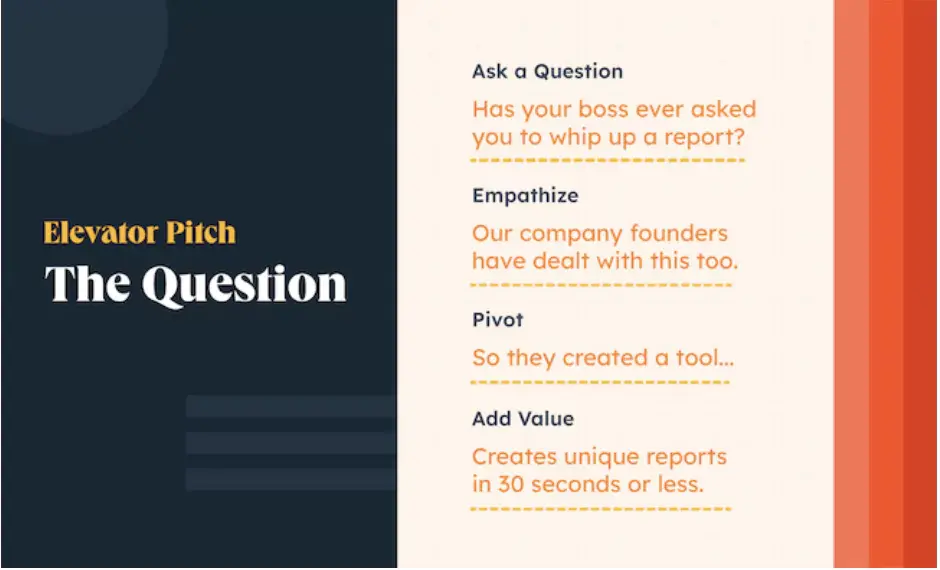
Has your boss ever asked you to “whip up a quick report before the end of the day?” You say yes with a sinking heart — because you know it'll be the opposite of quick. The founders of my company, AnswerASAP, constantly dealt with this problem in their roles as marketing executives. So they created a tool that puts all your data in one place and creates unique reports within 30 seconds or less.
This elevator pitch is effective because:
This pitch works on a few key levels: Right off the bat, it has a straightforward but compelling hook with that leading question — it's tailored to get your prospect to place themselves in a specific scenario.
It‘s also framed with language that strikes a balance between engaging and accessible — admittedly, it might be a bit folksy for some sales professionals’ tastes (the “sinking heart” piece could read as a little too melodramatic for some, but I like it), but it's still attention-grabbing.
It's also relatable and rooted in empathy. It calls out an “Oh geez, all of us in the industry have been there, am I right or am I right?” situation without being too hokey or heavy-handed — speaking to a key pain point that's general enough to cast a wide net but specific enough to cover a base the target audience deals with consistently.
It also doesn‘t get lost in covering technical specs or being imposingly jargon-y. It’s simple, straightforward, thoughtfully tailored, and effective.
2. The Credibility Boost
As an account executive for AnswerASAP, I talk to hundreds of marketers per month. And 99% of them hate creating reports. It‘s time-consuming, it’s tedious, and it‘s usually not your highest priority. That’s where our tool comes in — it pulls from all of your data to create any report you want in less than the time it takes to pour a cup of coffee.
This elevator pitch is effective because:
This one‘s big selling point is how it demonstrates authority. It leads off with the speaker calling out their clout, and sometimes, your pitch can benefit from a little flexing. This isn’t a time to be all "aw shucks-y" and modest — and rolling with this kind of pitch is one of the better ways to avoid that.
And like the previous one, it speaks to a “common but specific” pain point for the prospect on the other side of the pitch, covering an issue that many (if not most) marketers deal with consistently — and the “look at how many of your peers I talk to every month” element supports that.
And finally, it ends with an accessible but vivid metaphor about how efficient the resource is. I‘ll go out on a limb and assume that most prospects have poured a cup of coffee in their lives. It’s a frame of reference that's equal parts relatable and engaging — in short, it works.
3. The Surprise Ending
You want to know how many leads from your webinar campaign became customers versus leads from your trade show booth. But only customers who bought two products — and weren't already in your database.
How long would it take you to create that report?
If you had AnswerASAP, a data and reporting tool, you'd already know. It creates reports in a matter of seconds.
This elevator pitch is effective because:
Holy heck! My goodness! What a twist! Bet you didn't see that ending coming — and neither will your prospects!
Okay, that might be overkill, but still, this kind of pitch works — for a few reasons. For one, it starts with a relatable approach. It runs through a “common but specific” scenario that businesses in the prospect‘s industry likely deal with. That shows that you’re familiar with a prospect's space, giving you some instant credibility.
From there, it offers an engaging, cheeky way to plug your solution. You raise a pressing pain point and immediately position your offering as the best way to solve it. It's slick, creative, and fun — taken together, those elements give you some serious staying power.
4. An Outlandish Stat
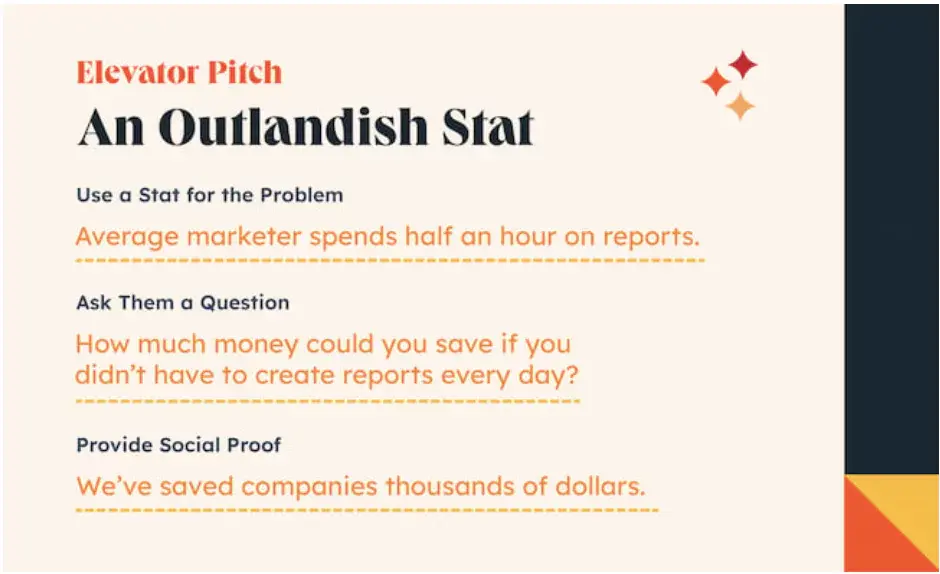
Your marketing team members will each spend approximately 8,730 minutes of their work year putting together reports. Across your teams and departments, how much money can you save if you took that chore off their to-do lists with AnswerASAP, the reporting tool that automatically pulls your data into an easy-to-read (and send) dashboard? We‘ve saved companies thousands of dollars per year, and they’re operating more efficiently than ever.
This elevator pitch is effective because:
Geez Louise! If you thought the last one was shocking, just wait until your prospects hear this one! Really though, citing outlandish numbers is one of the better ways to cultivate fact-based urgency — a real and justified gravity to your pitch.
It gives them a clear-cut sense of the price of inaction and positions your solution as the best way to avoid it. This might sound obvious, but pain points aren‘t actually pain points if you can’t convey that they're actually painful — that‘s kind of a mouthful, but it’s the best way I can put it. This kind of pitch is one of the more straightforward, interesting ways to get there.
5. The Story
The founders of my company were originally marketers. The worst part of their day, by far, was … Want to take a guess? No, it wasn‘t arguing with Sales. They detested making reports. I don’t blame them. You know what a pain in the neck it is. That's why they created AnswerASAP. You can create any report you want in a matter of seconds.
This elevator pitch is effective because:
Want to hear a story? This one time, cognitive psychologist Jerome Bruner theorized that people are 22 times more likely to remember a fact when it's presented as part of a story — he then went on to 28th most cited psychologist of the 20th century and lived to 100. The end.
You‘re probably wondering why I just shared that wild emotional roller coaster of a narrative. Well, reader who totally doesn’t think I‘m reaching with this description, it’s because the elevator pitch above it tells a story, too — and that ensures that virtually any prospect who hears something similar is going to remember what you have to say.
6. A Customer Story
Siena Rosen, a marketer at Dunder Mifflin, used to spend 30 minutes per day manually creating reports. Now that she uses AnswerASAP, that‘s gone down to four minutes. She’s making twice as many reports in less time. Our tool helps marketers like Siena answer any question on their mind (or their boss‘s) nearly instantly. If you’re curious, I can explain more.
This elevator pitch is effective because:
Remember that one time, way back when, when I talked about how people are 22 times more likely to remember a fact when it's presented as part of a story? The same principle applies here.
Telling a story where you reference a customer can make for a compelling narrative thread to an elevator pitch — along with some solid social proof to give you some immediate clout and demonstrated value.
7. The Reality Check
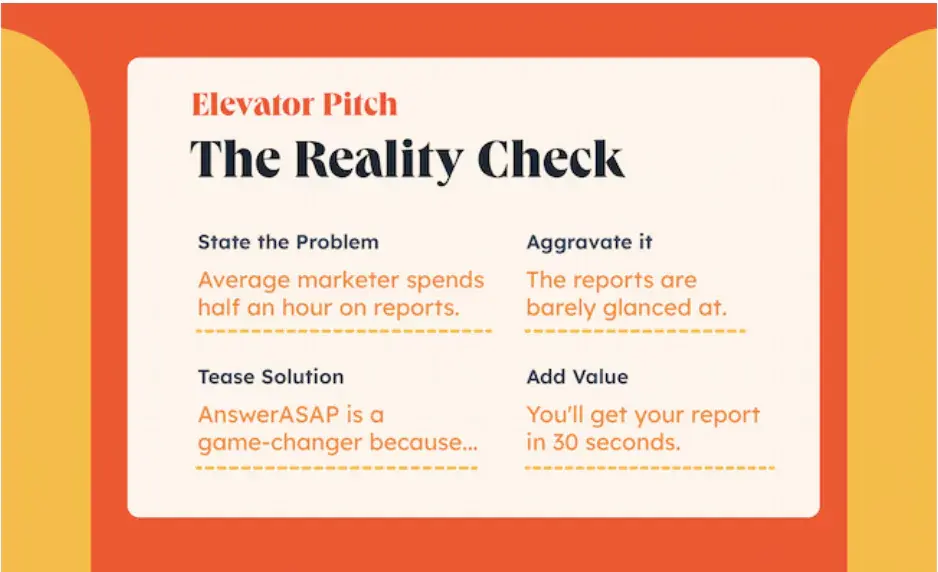
Every day, the average marketer spends half an hour putting together reports. Most of the time, these reports are barely glanced at — or worse, ignored altogether. AnswerASAP, which stores all of your data from every tool your business uses, is a game-changer here. Just type what report you want: For example, “A bar chart of revenue from every lead source in the past month.” You'll get your report in 30 seconds.
This elevator pitch is effective because:
I touched on it earlier, but revealing the price of inaction is often the best way to cultivate urgency in an elevator pitch — striking a chord by touching on a pain point … and again, a pain point isn‘t particularly valuable if it isn’t, well, painful.
This brand of elevator pitch leans into that trend. It walks your prospect through an engaging narrative where they're posed with a common problem and confronted with the all-too-common consequences of not solving it. That makes for some killer elevator pitch material.
8. The Joke
How many marketers does it take to do monthly reporting? None (if they've automated the process with AnswerASAP). Each employee that uses this tool saves 30 minutes per day on average, which is time they can spend on marketing tasks more worthy of their time such as improving performance on campaigns and increasing ROI across the board.
This elevator pitch is effective because:
This one can be tricky — it kind of hinges upon how funny your joke is, so leverage it at your own risk. That being said, if you can make your prospect chuckle, you have a pretty engaging elevator pitch on your hands.
It can be an instantly relatable, disarming way to demonstrate your familiarity with your prospect‘s industry — you can’t riff about the ins and outs of your prospect's industry without a somewhat intimate understanding of what they deal with.
9. The Emotional Appeal
When I started my career in marketing, I thought I would be making a difference for my organization right away, but as the junior member of the team, all the reporting and administrative tasks were pushed onto me. I was spending so much time creating reports for key stakeholders that could‘ve been diverted to more important revenue-generating activities. If you’re not using AnswerASAP, you‘re spending too much of the organization’s time, money, and talent on something that can be generated by our tool on-demand in 30 seconds.
This elevator pitch is effective because:
Relatability has been a pretty consistent thread through this list up to this point — and this one leans on it the most. Emotional appeals can be tough to navigate, but when done right, they make for some of the most resonant, common-ground-establishing pitches possible.
Playing on a prospect's emotions is one of the better ways to frame pain points as particularly pressing and create urgency in a 30-second window. This pitch also allows for a hard-hitting, “mic drop,” “moral of the story” conclusion — if you can stick the landing with one of those, you can really make an impression.
10. The One-Liner
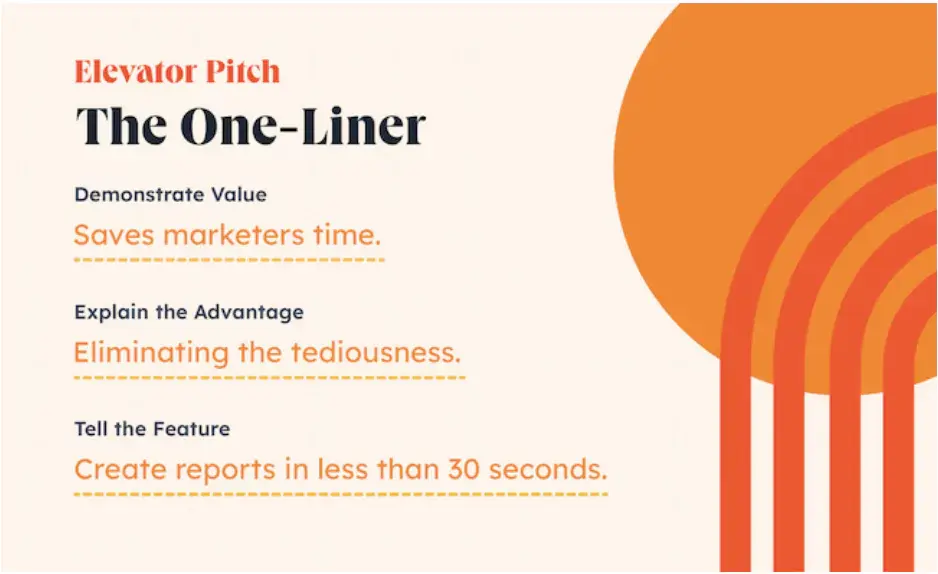
AnswerASAP saves marketers time by eliminating the tediousness of data gathering and formatting to create beautiful marketing reports in less than 30 seconds.
This elevator pitch is effective because:
This one strips your pitch back to the bare necessities. No flash, no frills — just your core message. Admittedly, this is one of the riskier options you can leverage. You're foregoing most of the 30 seconds you generally have to deliver a compelling but concise elevator pitch.
That said, if you feel like you can get an effective, resonant message across in a sentence or two, this one might be the one for you. Sometimes, trimming the fat is the way to go — it's a judgment call, but if you really think this kind of brevity will register with your prospect, you can roll with it.
11. The Mutual Connection
As I understand it, we have a mutual connection — Zachary Koch. He's actually a customer of ours. His company was able to cut its software development lifecycle in half by leveraging our solution. You two are industry partners of a similar scale, so you would likely see similar results. Would you like to hear more about what we did for him and could do for you?
This elevator pitch is effective because:
According to HubSpot's 2024 State of Sales report, referrals from existing customers generate the highest quality leads — a trend that points to how prospects generally trust other prospects more than the businesses that sell to them — so if your solution has worked for someone in a prospect's network, you should consider referencing that connection.
Even the most casual of name drops can give your elevator pitch some invaluable credibility — backing what you‘re saying with some social proof that’s especially close to home goes a long way.
12. The Advisor
In working with other budding B2B SaaS companies, we've found that one of the key issues they struggle with is content marketing. This past year we helped a number of your industry peers to create, publish, and promote blog content to support their inbound marketing efforts, resulting in an average 20% increase in leads generated. Would you like to hear more?
This elevator pitch is effective because:
This pitch gives you the space to demonstrate familiarity with a prospect's work and position yourself as a valuable, consultative resource whose specific insight is specifically positioned to help them … specifically.
It also balances actionable insight with hard results — which is more or less the best possible combination you can offer when trying to hook and build some quick-hit credibility with a prospect.
13. The Networker
Hi, it‘s nice to meet you! I’m Nathan with AnswerASAP. We've been able to help our clients cut down the time they spend creating reports from 30 minutes to 30 seconds, giving them more time to focus on revenue-generating work. Would you like to know more?
This elevator pitch is effective because:
I feel like I‘m saying this a lot, but I’ll say it again — you want to be conversational, approachable, and relatable when conducting an elevator pitch. This example checks those boxes. It's unimposing without sacrificing practicality and professionalism.
14. The Salesperson
Let me ask you something: do you actually enjoy manually creating reports? Neither do we. In fact, we at AnswerASAP hate it so much that we‘ve created an automated reporting tool that keeps all of your data in one place, allowing you to create customized reports in 30 seconds or less. We know you’re a growing company that needs a quick and easy way to create reports without taking away time from high-priority tasks, and AnswerASAP can help you with that. Is this something you'd like to learn more about?
This elevator pitch is effective because:
An elevator pitch like this one is effective because it immediately calls out a common pain point and positions your offering as the best possible solution. It also covers some key benefits and poses a call to action at the end.
15. Business Owner to Business Owner
I‘m obsessed with your products at ABC Inc. and I’m so inspired by the work that you do. However, I'm going to be honest, I noticed some major opportunities to improve your reporting processes and overall efficiency. Have you ever thought about switching to an automated reporting system? It could help lower your time spent creating reports down to just a few seconds.
This elevator pitch is effective because:
You know what (almost) everyone loves? A little tasteful flattery. You know what this one is structured around? Exactly that. It leads off with a thoughtful compliment — one that‘s supported by some insight that speaks to legitimate knowledge about the prospect’s business.
.png)
Download Now: Free Elevator Pitch Templates
E-pitch templates to better sell your product, fund your business, or network.
- 4 Fundraising Pitch Templates
- 2 Networking Pitch Templates
- 2 Sales Pitch Templates
Elevator Pitches From Real Sales Leaders
1. "Streamline web project management with Webvizio."
Dan Ponomarenko, CEO of Webvizio, offered this pitch:
“At Webvizio, we streamline web project management for digital teams, making collaboration seamless. Our platform allows you to visualize changes, communicate in real time, and manage feedback efficiently — all in one place. We eliminate the clutter of back-and-forth emails, so you can focus on what you love: creating. Interested in simplifying your project processes and enhancing team productivity?”
2. "Deliver a clear tech talent solution with EchoGlobal Tech."
Lou Reverchuk, Co-Founder and CEO of EchoGlobal Tech, offered this pitch:
“Hello, I‘m Lou, representing EchoGlobal Tech, where we bridge the gap between innovative tech projects and top remote software developers. At EchoGlobal, we understand that the right talent makes all the difference. That’s why we guarantee no AI matchmaking and no juniors pretending to be senior devs. Always quality over quantity with us. Imagine having a dedicated expert who truly understands your project‘s vision and transforms it into reality. Let’s set up a time to discuss your hiring needs.”
3. "Simplify the insurance buying experience with Dundas Life"
Gregory Rozdeba, CEO of Dundas Life, offered this pitch:
“Imagine buying life insurance the way you shop online — quick, easy, and transparent. At Dundas Life, we streamline the complex process of finding the right insurance, making it accessible at your fingertips. With us, you‘re not just a policy number; you’re in control, informed, and secure. Let’s make insurance straightforward together.”
4. "Engage with real estate investment expertise with EZ Sell Homebuyers."
Mike Wall, CEO of EZ Sell Homebuyers, offered this pitch:
“Looking to maximize your real estate investment? With over two decades of experience and a portfolio of over 30 properties, I provide tailored advice that turns real estate into real results. Let’s discuss how I can help you achieve your property investment goals today.”
5. "Enhance your online visibility with CodeDesign."
Bruno Gavino, Founder and CEO of CodeDesign, offered this pitch:
“Hi, I’m Bruno from CodeDesign. We often see companies struggle to gain visibility in the digital space, losing potential revenue to competitors who dominate online. Our agency specializes in leveraging advanced data analytics and custom digital strategies to enhance your online presence, driving more traffic and increasing sales. Imagine what it would be like to see your business outperform competitors by simply optimizing your digital marketing. Let’s chat about how we can make that happen for you.”
6. "Illuminate spaces with quality lighting with Festoon House."
Matt Little, Director at Festoon House, offered this pitch:
“Imagine transforming your space with lighting that‘s not only beautiful but also built to last. At Festoon House, we’re dedicated to crafting premium lighting solutions that elevate your style, enhance your ambiance, and stand the test of time. From modern chandeliers to industrial-chic fixtures, our products are designed to inspire and impress. Join the Festoon House family and let's brighten up your world together — one light at a time!”
7. "Solve food waste with RedBat.Agency."
Gert Kulla, CEO of RedBat.Agency, offered this pitch:
“We're tackling the issue of food waste in restaurants. Our app allows diners to buy surplus food at a discount while helping venues reduce waste and generate extra revenue. This creates a win-win for businesses and customers looking to save money and curb food waste.”
8. "Elevate travel with JetLevel Aviation."
Fahd Khan, Director of Marketing and Technology at JetLevel Aviation, offered this pitch:
“At JetLevel Aviation, we provide top-tier private jet charter services, ensuring fast, flexible, and seamless travel for high-profile clients. Unlike traditional charter companies, our bespoke solutions and access to a wide range of luxury jets guarantee that your travel experience is not just efficient but also tailored to your specific preferences and schedules. Let us elevate your travel experience to the next level.”
Elevator Speech Best Practices
1. Keep it brief.
The purpose of an elevator speech is to be as brief as possible while capturing a prospect‘s attention. Try to stay under 60 seconds — including your introduction. Even if you’re delivering your elevator speech during a formal presentation, where you have time to elaborate if needed, keep the bulk of your pitch under sixty seconds.
If you don‘t, you won’t be able to use your pitch when you're chatting with prospects in situations with tighter time constraints — such as a tradeshow or a chance meeting.
2. Practice multiple times beforehand.
You may have written the most incredible elevator speech for your product, but if you hamper the delivery by misremembering or even forgetting parts of your pitch, it won't be an effective tool. Be sure to practice by yourself, with your manager, and with your colleagues.
The goal isn't just to memorize it, but to practice your tone, pace, and overall delivery.
3. Come prepared with additional materials.
When you‘re delivering your elevator pitch, be prepared to provide your prospect with what they need to continue the conversation. Whether that’s a business card, a brochure, or a short demo, carry all that you might need with you.
The elevator speech is your opportunity to begin a deal on the right foot and speed up the nurturing process. Typically, you might take weeks emailing a prospect before they're ready to schedule a meeting with you, but an elevator pitch speeds that work. You want to have the materials you need to keep the conversation going.
4. Be positive and enthusiastic.
It‘s essential to show your personality during your elevator pitch, but whether you’re a quiet, calm introvert or a charming, excitable extrovert, you should still convey positivity and enthusiasm.
You can use your body language and expression to keep things positive, even if your tone is quiet and calm. You might highlight the amazing benefits your prospect will enjoy if they sign up, or tell a positive story from one of your previous clients.
Most importantly, you should make it obvious that you want to help your prospect more than anything — which will make you sound positive by default.
5. Vary the tone of your voice.
As you deliver your pitch, vary your tone and modulation to keep your listener engaged. This will help you emphasize the most important parts of your speech — such as the benefits — while keeping your prospect‘s attention. The pitch may be short, but you’ll be surprised at how easily people can tune out based on your tone alone. We don‘t want to risk it! Especially if it’s a prospect you've never spoken with.
What Not to Do in an Elevator Pitch
Check out the video for a quick, 60-second refresher on this subject — and/or read the content below it for a series of ineffective elevator pitch examples.
1. Don't ramble.
I‘ve been a rep at Sales-R-Us for five years now. They’re the best company I‘ve ever worked for. I’ve loved my time there. I started as a BDR and have worked my way up to a senior position. I‘ve never looked back. I also love the services we sell. I can’t wait to tell you about them. Sales-R-Us help companies become more efficient with their sales through training, evaluation, and leadership management — and that‘s just to name a few. We have a unique approach that’s been honed by lots of sales experts over the years, and I‘ve seen our solution really help a lot of companies and teams. I’ve had many clients whose businesses have been saved because of our genius solution. I know we can do the same for you. Would you be interested in learning more?
This elevator pitch is not effective because:
- It's way too long.
- The rep spends way too much time talking about themself.
- It never gets specific or actionable.
- It never provides actual examples or attention-grabbing facts.
2. Don't use too much jargon.
At Stratosphere Solutions, our OS-level virtualization delivers software in containers, all of which share the system of a lone operating system kernel. These containers are isolated but can communicate with one another through well-defined channels. Ultimately, this lets you use fewer resources than traditional virtual machines.
This elevator pitch is not effective because:
- It's inaccessible to someone without relevant technical knowledge.
- It features too much jargon.
- It tries to condense an extremely complicated topic into 30 seconds.
- Its value proposition isn't clear-cut.
3. Don‘t insert your prospect’s personal information.
I visited your Instagram and noticed that you have a pitbull. I have a pitbull, too! I bet he sometimes distracts you when you work from home, which is the absolute pits when you‘re trying to put together a report for your boss. Your dog — what’s his name? — may be asking for your attention, but I assure you you can still create a report as easy as 1-2-3 with AnswerASAP. While petting your pupperino.
This elevator pitch is not effective because:
- It sacrifices the hook in favor of creating a “personal connection.”
- It's too familiar with the prospect to the point of discomfort.
- It makes assumptions about the prospect's work-from-home tendencies.
- It uses informal slang (“the absolute pits,” “pupperino”) for unnecessary humor.
4. Don‘t under-emphasize the problem you’re solving.
It's possible that you may run into issues when putting reports together for your boss. For instance, things may go awry every once in a while, such as disappearing data or disagreeing sources. With AnswerASAP, you can lay those worries to rest. We have a few features that will help you with those issues if you ever run into them.
This elevator pitch is not effective because:
- It treats a customer problem as a possibility and not an urgent reality.
- It‘s vague (“things may go awry”) and doesn’t emphasize how those issues can hurt the prospect.
- It doesn‘t specify the product features that will solve the prospect’s challenges.
- Because it never goes into detail, it shows little research and care.
Remember, an elevator pitch should only come at someone else‘s prompting. If you’re spontaneously reciting it to random people, you're not doing yourself any favors. But if they ask, you want to be prepared with an interesting, well-crafted pitch.
Reel in Clients with an Effective Elevator Pitch
While a short speech may seem insignificant, those first conversations can hold some weight. With a well-crafted pitch, you can turn a single conversation with a prospect into a long-lasting customer, or even into a business partner. We hope you found these examples helpful and are inspired to craft your own effective elevator pitch.
Editor's note: This post was originally published in August 2019 and has been updated for comprehensiveness.




![The Complete Guide to Business Networking [+8 Key Tips You Should Leverage]](https://blog.hubspot.com/hubfs/business-networking-fi%20%281%29.jpg)
![Why Networking is Important [+ How to Get it Right]](https://blog.hubspot.com/hubfs/why-networking-is-important.jpg)
![Making the Most of Virtual Networking [+How to Get it Right]](https://blog.hubspot.com/hubfs/virtual-networking.jpg)
![How to Network Remotely in Sales [+ Tips]](https://blog.hubspot.com/hubfs/Network%20%281%29.jpg)

